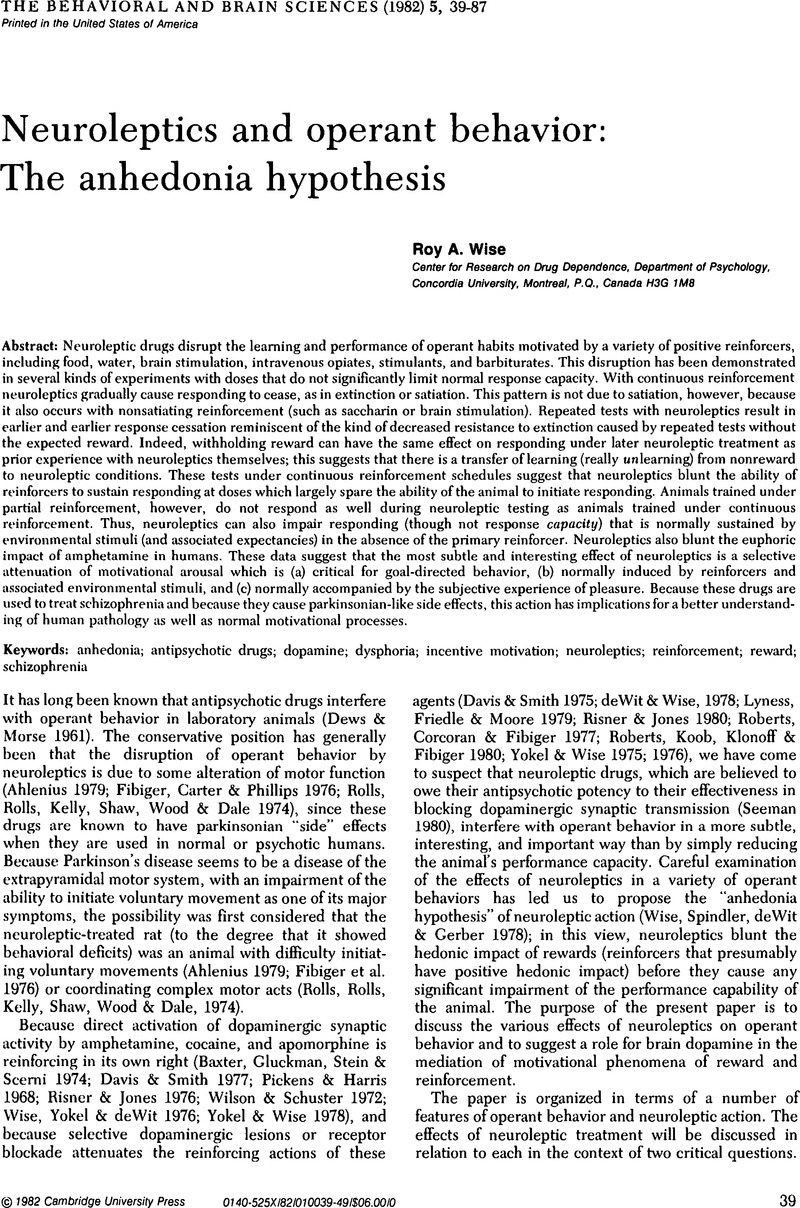Crossref Citations
This article has been cited by the following publications. This list is generated based on data provided by Crossref.
Goeders, Nick E.
Lane, John D.
and
Smith, James E.
1984.
Self-administration of methionine enkephalin into the nucleus accumbens.
Pharmacology Biochemistry and Behavior,
Vol. 20,
Issue. 3,
p.
451.
Wise, Roy A.
and
Colle, Lois M.
1984.
Pimozide attenuates free feeding: Best scores analysis reveals a motivational deficit.
Psychopharmacology,
Vol. 84,
Issue. 4,
p.
446.
Lynch, Minda R.
and
Wise, Roy A.
1985.
Relative effectiveness of pimozide, haloperidol and trifluoperazine on self-stimulation rate-intensity functions.
Pharmacology Biochemistry and Behavior,
Vol. 23,
Issue. 5,
p.
777.
Wise, Roy A.
and
Holmes, Larry J.
1986.
Circling from unilateral VTA morphine: Direction is controlled by environmental stimuli.
Brain Research Bulletin,
Vol. 16,
Issue. 2,
p.
267.
Jenck, Francois
Gratton, Alain
and
Wise, Roy A.
1986.
Effects of pimozide and naloxone on latency for hypothalamically induced eating.
Brain Research,
Vol. 375,
Issue. 2,
p.
329.
Goeders, Nick E.
and
Smith, James E.
1987.
Intracranial self-administration methodologies.
Neuroscience & Biobehavioral Reviews,
Vol. 11,
Issue. 3,
p.
319.
Wise, Roy A.
1987.
The role of reward pathways in the development of drug dependence.
Pharmacology & Therapeutics,
Vol. 35,
Issue. 1-2,
p.
227.
Colle, Lois M.
and
Wise, Roy A.
1987.
Opposite effects of unilateral forebrain ablations on ipsilateral and contralateral hypothalamic self-stimulation.
Brain Research,
Vol. 407,
Issue. 2,
p.
285.
Colle, Lois M.
and
Wise, Roy A.
1988.
Effects of nucleus accumbens amphetamine on lateral hypothalamic brain stimulation reward.
Brain Research,
Vol. 459,
Issue. 2,
p.
361.
Blackburn, James R.
Pfaus, James G.
and
Phillips, Anthony G.
1992.
Dopamine functions in appetitive and defensive behaviours.
Progress in Neurobiology,
Vol. 39,
Issue. 3,
p.
247.
Calcagnetti, Daniel J.
and
Schechter, Martin D.
1992.
Attenuation of drinking sweetened water following calcium channel blockade.
Brain Research Bulletin,
Vol. 28,
Issue. 6,
p.
967.
Koob, George F.
1992.
Dopamine, addiction and reward.
Seminars in Neuroscience,
Vol. 4,
Issue. 2,
p.
139.
Maremmani, I.
Zolesi, O.
Daini, L.
Capone, M. R.
Aglietti, M.
and
Castrogiovanni, P.
1995.
Drug Addiction and Related Clinical Problems.
p.
51.
Martin, Rodger
and
Adawi, Samir al
2000.
Psychiatric treatments: an exciting new century.
Hospital Medicine,
Vol. 61,
Issue. 8,
p.
524.
Wise, Roy A.
2004.
Dopamine, learning and motivation.
Nature Reviews Neuroscience,
Vol. 5,
Issue. 6,
p.
483.
Wise, Roy A
2006.
Role of brain dopamine in food reward and reinforcement.
Philosophical Transactions of the Royal Society B: Biological Sciences,
Vol. 361,
Issue. 1471,
p.
1149.
Wise, Roy A.
2008.
Dopamine and reward: The anhedonia hypothesis 30 years on.
Neurotoxicity Research,
Vol. 14,
Issue. 2-3,
p.
169.
Palomo, Tomas
Beninger, Richard J.
Kostrzewa, Richard M.
and
Archer, Trevor
2008.
Affective status in relation to impulsive, motor and motivational symptoms: Personality, development and physical exercise.
Neurotoxicity Research,
Vol. 14,
Issue. 2-3,
p.
151.
Redolar Ripoll, Diego
2008.
Consolidación de la memoria, sustrato nervioso del refuerzo y adicción.
Psiquiatría Biológica,
Vol. 15,
Issue. 4,
p.
109.
Colombo, Matteo
2014.
Deep and beautiful. The reward prediction error hypothesis of dopamine.
Studies in History and Philosophy of Science Part C: Studies in History and Philosophy of Biological and Biomedical Sciences,
Vol. 45,
Issue. ,
p.
57.



